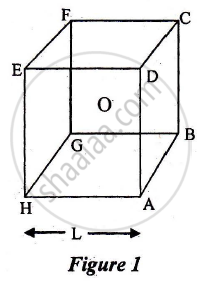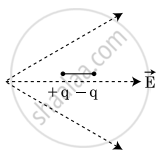Advertisements
Advertisements
Question
A sample of HCI gas is placed in an electric field of 2.5 × 104 NC−1. The dipole moment of each HCI molecule is 3.4 × 10−30 Cm. Find the maximum torque that can act on a molecule.
Solution
Given:
Electric field intensity, E = 2.5 × 104 NC−1
Dipole moment of an HCl molecule, P = 3.4 × 10−30 Cm
Torque on the molecule,
\[\Gamma = PE\sin\theta\]
For
\[ = 3 . 4 \times {10}^{- 30} 2 . 5 \times {10}^4 \]
\[ = 8 . 5 \times {10}^{- 26} \] Nm
APPEARS IN
RELATED QUESTIONS
Derive the expression for the electric potential due to an electric dipole at a point on its axial line.
A short electric dipole (which consists of two point charges, +q and -q) is placed at the centre 0 and inside a large cube (ABCDEFGH) of length L, as shown in Figure 1. The electric flux, emanating through the cube is:

a) `q"/"4piin_9L`
b) zero
c) `q"/"2piin_0L`
d) `q"/"3piin_0L`
Find the resultant electric field due to an electric dipole of dipole moment, 2aq, (2a being the separation between the charges ±± q) at a point distant 'x' on its equator.
An electric dipole of length 2 cm, when placed with its axis making an angle of 60° with a uniform electric field, experiences a torque of \[8\sqrt{3}\] Nm. Calculate the potential energy of the dipole, if it has a charge \[\pm\] 4 nC.
In which orientation, a dipole placed in a uniform electric field is in (i) stable, (ii) unstable equilibrium?
Two particles A and B, of opposite charges 2.0 × 10−6 C and −2.0 × 10−6 C, are placed at a separation of 1.0 cm. Calculate the electric field at a point on the perpendicular bisector of the dipole and 1.0 m away from the centre.
In an electric dipole, at which point is the electric potential zero ?
A uniform electric field is prevailing in X - direction in certain region. The coordinates of points P, Q, and R are (0, 0), (2, 0) and (0, 2) respectively. Which of the following alternatives is true for the potentials at these points?
Dimensions of mass in electric field and in electric dipole moment are respectively.
An electric dipole is placed at an angle of 30° to a non-uniform electric field. The dipole will experience ________.
A conic surface is placed in a uniform electric field E as shown in the figure such that the field is perpendicular to the surface on the side AB. The base of the cone is of radius R, and the height of the cone is h. The angle of the cone is θ.

Find the magnitude of the flux that enters the cone's curved surface from the left side. Do not count the outgoing flux (θ < 45°)
The unit of electric dipole moment is ______.
A dipole is placed in an electric field as shown. In which direction will it move?

The electric field in a region is given by `vec"E" = 2/5"E"_0hat"i"+3/5"E"_0hat"j"` with `"E"_0 = 4.0xx10^3 "N"/"C"`. The flux of this field through a rectangular surface area 0.4 m2 parallel to the Y - Z plane is ______ Nm2C-1.
In an electric dipole, what is the locus of a point having zero potential?
